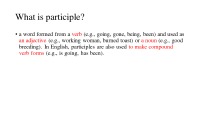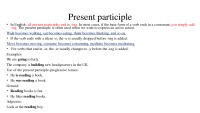Presentation About Participle



Participle. What is participle? A word formed. Present participle. In English, all present participles end in -ing. Past participles. The past participle is often used when we want to express a passive action. Perfect participle. The perfect participle indicates completed action. Using Participles. Participles are used with. Participles are used. Adjective participle. When you make. Whenever we have. Questions. Hearing a loud noise, we ran to the window. Answers. Hearing – participle, qualifying the pronoun we. The End.
Whenever we have the relative pronoun of the adjective clause working also as the subject and we have a be verb, we can take them both out and leave only the participle. The jazz musician, who is/was known for his tendency to daydream, got into a zone and played for an hour straight. If there’s only a adjective participle without any words after him, we put him before the noun. The window that was broken, was fixed. Past participle: The broken window was fixed. When it is identifying adjective clause we don’t need comma. The Woman who is talking to Jeff is his sister. If we have relative pronoun, active verb- we can squeeze them both together and we get the participle. The station chief was fired, which means there’s an open position. We can change which means into a meaning.
- Languages Presentations
- MS PowerPoint 94 KB
- 2019 m.
- English
- 12 pages (937 words)
- University
- Paulius

















